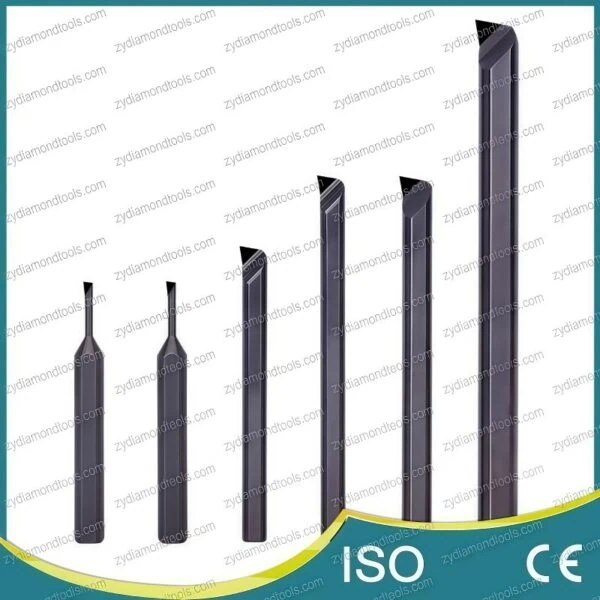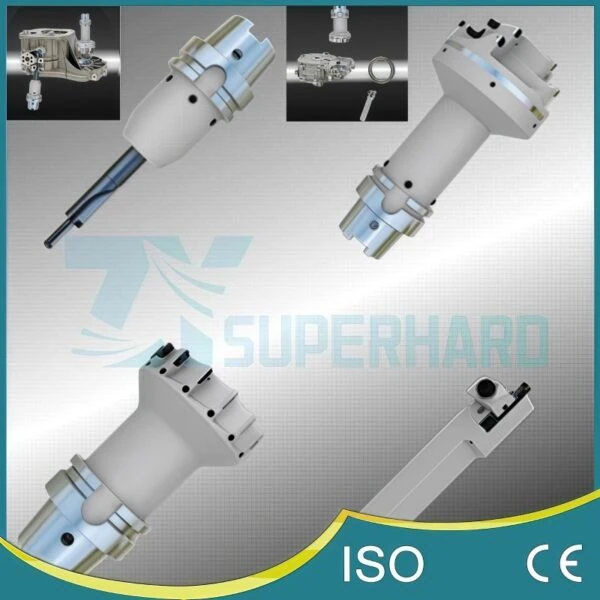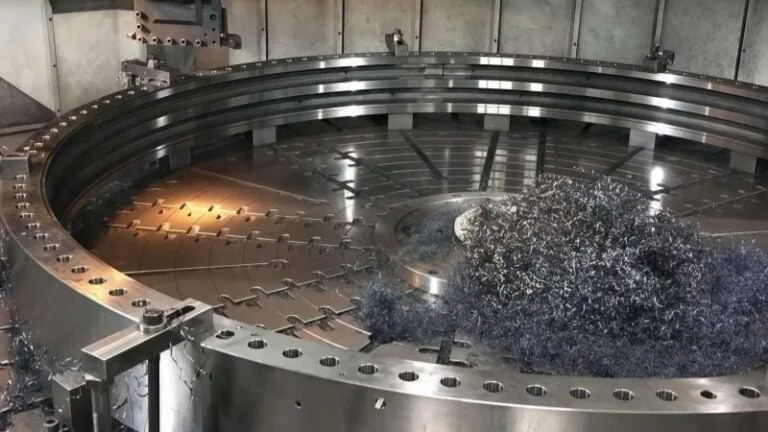-
Whatsapp: +86 13526572721
-
Email: info@zydiamondtools.com
-
Address: AUX Industrial Park, Zhengzhou City, Henan Province, China
-
Whatsapp: +86 13526572721
-
Email: info@zydiamondtools.com
-
Address: AUX Industrial Park, Zhengzhou City, Henan Province, China

Why Choose PCBN Boring Bars and How to Select the Right One for Hard Material Machining?

Thinking about using PCBN boring bars for tough jobs, but want to know why they’re chosen and how to pick and use the right one?
Choosing and using PCBN boring bars effectively for hard material machining involves understanding their key advantages like superior hardness and speed, knowing their primary applications in hardened steel and cast iron components across industries like automotive and aerospace, selecting the appropriate grade, geometry, and bar based on material and cut type, and applying critical usage tips regarding cutting parameters, machine rigidity, coolant strategy, and wear monitoring.
What Key Advantages Do PCBN Boring Bars Offer for Hard Materials?
So, when you’re facing really tough, hard metals, what makes PCBN boring bars stand out from the crowd?
PCBN (Polycrystalline Cubic Boron Nitride) boring bars offer significant benefits for machining hard ferrous materials, primarily due to their exceptional hardness and wear resistance, which enables higher cutting speeds, produces excellent surface finishes, often outperforms other tool materials like carbide and ceramics in specific hard applications, and can lead to reduced cycle times and lower overall costs per part.
Superior Hardness and Wear Resistance Explained
Imagine trying to cut something extremely hard, like hardened steel used in gears or bearings. You need a tool material that’s even harder, right? That’s where PCBN shines.
PCBN is one of the hardest materials available for cutting tools, second only to diamond. This incredible hardness means it can effectively cut through very hard metals (typically above 45 HRC, or Rockwell Hardness C scale) without deforming or breaking down quickly.
This hardness directly leads to outstanding wear resistance. What does that mean?
- Longer Tool Life: PCBN tools resist abrasion (wearing away) much better than traditional carbide tools when machining hard, abrasive materials like hardened steels or certain types of cast iron. This means one PCBN boring bar can machine many more parts before needing replacement compared to carbide. For instance, in demanding hard turning operations, it’s not uncommon to see PCBN inserts last 5 to 10 times longer, or even more, than comparable carbide inserts, significantly reducing downtime for tool changes.
- Consistency: Because they wear down slowly and predictably, PCBN tools maintain their cutting edge and shape for longer. This results in more consistent part quality from the first piece to the last.
This combination makes PCBN exceptionally durable when tackling the toughest boring jobs.
Achieving High Speeds and Excellent Surface Finish in Hard Turning/Boring
Because PCBN is so hard and resists heat extremely well (it remains stable at very high temperatures where other materials might soften), it allows for much faster cutting.
- Higher Cutting Speeds: You can often run PCBN boring bars at significantly higher speeds (Surface Feet per Minute or Meters per Minute) compared to carbide when machining hard materials. This directly translates to getting the job done faster. While specific speeds vary greatly, PCBN might enable cutting speeds 3-5 times higher than carbide in suitable hard turning applications. Remember, optimal cutting speeds depend heavily on the exact material being cut, the specific PCBN grade used, and your machine’s capability, so always consult your tool supplier’s recommendations.
- Excellent Surface Finish: PCBN tools can produce incredibly smooth surface finishes on hard parts. The material’s fine grain structure allows for very sharp, precise cutting edges. This often results in finishes that meet or exceed grinding quality (measured in Ra – Roughness average). Why is this important? In many cases, using PCBN for finish boring can eliminate the need for a separate grinding operation, saving significant time, equipment cost, and handling. This process, often called “hard turning1” or “hard boring,” replaces traditional grinding.
Achieving both speed and a fine finish simultaneously is a key advantage, boosting productivity without sacrificing quality.
Comparing PCBN vs. Carbide and Ceramics for Specific Hard Applications
PCBN isn’t the best tool for every job, but it excels in its specific niche. How does it compare to other common tool materials for boring?
| Feature | Tungsten Carbide | Ceramics (e.g., Alumina, Silicon Nitride) | PCBN |
|---|---|---|---|
| Primary Strength | Toughness, Versatility (softer mats) | High Speed (Cast Iron, some steels) | Extreme Hardness, Wear Resistance (Hard Mats) |
| Best Application | Steels < 45 HRC, general purpose | High-speed finishing of Cast Iron, some HS | Hardened Steels (>45 HRC), Hard Cast Iron |
| Hardness | Good | Very Good | Exceptional (Near Diamond) |
| Heat Resistance | Moderate | High | Very High |
| Toughness | High | Low to Moderate (Brittle) | Moderate (Less tough than Carbide) |
| Typical Weakness | Wears quickly on very hard materials | Can chip easily, limited applications | More brittle than carbide, higher cost |
When does PCBN win?
- Hardened Steel Boring (>45 HRC, often 55-65 HRC): This is PCBN’s home turf. Carbide wears too fast, and ceramics might not have the right properties or toughness. PCBN provides the necessary wear resistance and heat tolerance.
- High-Wear Cast Iron Boring: For abrasive cast irons (like gray iron or ductile iron, especially with hard spots), PCBN often offers much longer life than ceramics or carbide, particularly in high-volume production like automotive engine blocks or brake components.
- Replacing Grinding: When aiming for fine finishes and tight tolerances on hard parts directly through boring/turning.
Carbide remains the go-to for softer materials and applications demanding high toughness (resistance to chipping/breaking). Ceramics have their place, especially for high-speed cast iron finishing, but PCBN often provides a more reliable solution for the hardest ferrous boring tasks.
Impact on Cycle Times and Overall Machining Costs
At first glance, PCBN boring bars seem more expensive than carbide tools. So, how can they actually save money? The answer lies in the total cost per machined part.
- Reduced Cycle Times: As mentioned, PCBN allows for significantly higher cutting speeds. Machining parts faster directly reduces the time it takes to complete each one (cycle time). In high-volume production, even saving a few seconds per part adds up to massive time savings overall. For example, switching from grinding to hard boring with PCBN on an automotive transmission gear might cut the finishing time for that specific operation by 50% or more.
- Less Downtime: Longer tool life means fewer stops to change worn-out tools. Tool changes take time – time when the machine isn’t making parts. Reducing the frequency of these changes increases machine uptime and overall output.
- Process Consolidation: Eliminating grinding steps simplifies the manufacturing process, potentially reducing the number of machines needed, floor space requirements, and part handling logistics.
- Lower Cost Per Part: When you factor in the faster machining, longer tool life, reduced downtime, and potential elimination of secondary operations like grinding, the higher initial cost of the PCBN tool is often easily offset. The cost per finished component can be substantially lower, especially in automotive, aerospace, or mold/die industries where hard materials and high precision are common.
Therefore, while the upfront investment is higher, adopting PCBN boring bars for suitable hard material applications is often a strategic move to significantly boost productivity and lower manufacturing costs in the long run.
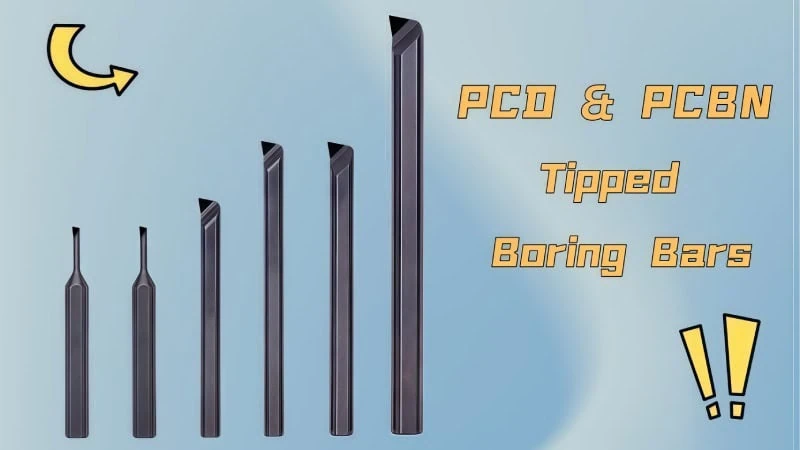
Where are PCBN Boring Bars Most Effectively Applied?
Knowing the advantages is great, but where exactly do PCBN boring bars make the biggest difference in the real world?
PCBN boring bars are most effectively applied when machining hard ferrous materials, particularly hardened steel components like gears, shafts, bearings, and molds; various cast iron parts such as brake discs, engine blocks, and pump housings; and in specific finishing operations for powder metallurgy parts and some superalloys. Consequently, key industries like automotive, aerospace, and heavy machinery heavily rely on PCBN boring.
Machining Hardened Steel Components (Gears, Shafts, Bearings, Molds & Dies)
Hardened steel is steel that’s been heat-treated to make it very hard and strong, usually measuring above 45 HRC and often reaching 55-65 HRC. Many critical machine parts are made from hardened steel because they need to resist wear and handle heavy loads. However, this hardness makes them difficult to machine accurately with traditional tools after they’ve been hardened. PCBN boring bars are ideal for these situations.
Common hardened steel components finished with PCBN boring include:
- Gears: Think about the gears in a car’s transmission. They need to be extremely hard to avoid wearing down quickly, and their teeth must be shaped very precisely to mesh smoothly. PCBN allows for boring and finishing operations on the internal features of gears after hardening, ensuring accuracy.
- Shafts: Many shafts, like those in engines or motors, have hardened surfaces (especially where bearings sit) that require precise internal boring for fitment or features.
- Bearings: The inner and outer rings of bearings are typically made of hardened steel and require exceptionally smooth and dimensionally accurate internal surfaces (bores) to function correctly. PCBN boring provides this precision.
- Molds & Dies: Tools used to shape plastic or metal (molds and dies) are often hardened to withstand repeated use. PCBN is used to bore precise features into these hardened tool steels.
Essentially, anytime you need to create accurate internal shapes in already hardened steel parts, PCBN boring is a primary solution.
Boring Cast Iron Parts (Brake Discs/Drums, Engine Blocks, Pump Housings)
Cast iron is another common material, especially in the automotive world. While generally not as hard as fully hardened steel, it can be very abrasive and sometimes contain hard spots or inclusions that wear out tools quickly. PCBN excels here too.
Typical cast iron applications include:
- Brake Discs/Drums: The internal mating surfaces of brake drums or the central mounting bore of brake discs need smooth finishes and accurate dimensions for proper function and longevity. PCBN handles the abrasive nature of cast iron well during high-volume production.
- Engine Blocks: The cylinder bores where pistons move must be perfectly round, straight, and have a specific surface finish for engine efficiency and oil retention. PCBN boring is frequently used for finish boring these cylinders in cast iron blocks.
- Pump Housings: Many pumps use cast iron bodies. Boring the internal chambers and passages accurately is critical for pump performance, and PCBN provides the tool life needed for efficient manufacturing.
PCBN’s wear resistance makes it highly effective for maintaining tight tolerances and achieving long tool life when boring abrasive cast iron components.
Processing Powder Metallurgy Parts and Select Superalloys
While hardened steel and cast iron are the mainstays, PCBN boring also finds use in other challenging materials:
- Powder Metallurgy (PM) Parts: These parts are made by pressing metal powders together and then heating them (sintering). The resulting material can sometimes be quite abrasive or have hard phases. PCBN can be effective for finish boring operations on certain hard PM components.
- Select Superalloys2: Superalloys (often nickel-based or cobalt-based) are used in extreme environments like jet engines or turbines because they maintain strength at high temperatures. They are notoriously difficult to machine. While not a universal solution, PCBN is sometimes used for specific finishing boring operations on certain superalloys where high hardness and wear resistance are needed, and other tool materials fail. Application here is very specific and requires careful grade selection.
These applications are more specialized but highlight PCBN’s capability in truly demanding materials.
Key Industries Benefiting from PCBN Boring (Automotive, Aerospace, Heavy Machinery)
Given the types of components machined, it’s clear which industries rely heavily on PCBN boring technology:
- Automotive: This is perhaps the largest user. Think engine components (blocks, crankshafts, connecting rods), transmission parts (gears, shafts), braking systems (discs, drums), and steering components. High volumes and the need for cost-effective machining of hard/abrasive materials make PCBN essential.
- Aerospace: Aerospace demands high precision and reliability, often using difficult-to-machine materials including hardened steels and some superalloys for components like landing gear parts, engine shafts, and turbine components. PCBN helps achieve the required specifications.
- Heavy Machinery & Equipment: Industries manufacturing construction equipment, agricultural machinery, hydraulics, and large industrial gearboxes use PCBN for boring large, heavy-duty components made from hardened steels and cast irons, such as hydraulic cylinder bores, large gear internals, and bearing housings.
- Mold & Die: This industry requires high accuracy and excellent surface finishes on hardened tool steels to produce quality molds for manufacturing other goods.
Essentially, any industry that requires precise internal machining on hard or highly abrasive ferrous materials is a potential beneficiary of PCBN boring technology.
How Do You Choose the Right PCBN Grade and Geometry?
Alright, you know PCBN is great for hard materials, but with so many options, how do you pick the exact right tool for your specific boring job?
Choosing the right PCBN boring bar involves matching the specific PCBN grade to the material being cut (like hardened steel or cast iron) and its hardness, understanding how CBN content and binder type affect toughness versus wear resistance, selecting the appropriate insert shape and edge preparation for the cut type, and determining the correct boring bar dimensions and shank material for stability.
Matching PCBN Grades to Material Hardness and Type (Focus on Specific Grades for Steel vs. Iron)
Think of a PCBN “grade” as a specific recipe developed by the tool manufacturer. Just like different recipes work best for different kinds of food, different PCBN grades are designed to perform best on specific materials.
- Material is Key: The first step is knowing exactly what you’re cutting. Is it a type of hardened steel? What is its hardness rating (HRC)? Is it gray cast iron or ductile cast iron? Different materials interact differently with the cutting tool.
- Manufacturer Grades: Tool suppliers create grades optimized for certain materials.
- Some grades are specifically designed for hardened steels (typically > 45 HRC). These often prioritize wear resistance and heat tolerance.
- Other grades are formulated for cast irons, focusing on toughness to handle the material’s abrasiveness and potential inconsistencies.
- There might even be grades for more specialized materials like powder metals or superalloys discussed earlier.
- Hardness Matters: Within hardened steels, the specific hardness level (e.g., 50 HRC vs. 65 HRC) can influence the best grade choice. Harder materials generally require grades with higher wear resistance.
Crucial Point: PCBN grade naming and compositions vary significantly between manufacturers. Always consult your tooling supplier’s catalog or technical support to find the recommended grade for your specific material type and hardness. They have detailed charts and experience to guide this critical choice.
Understanding CBN Content and Binder Influence (Low vs. High CBN Choices)
PCBN tools aren’t made of 100% pure Cubic Boron Nitride. They consist of tiny CBN particles held together by another material, called a binder. The amount of CBN versus binder dramatically changes how the tool performs. (For a deeper dive, see Your Complete Guide to CBN (Cubic Boron Nitride) Cutting Tools3).
| Feature Comparison | Low CBN Content (Higher Binder %) | High CBN Content (Lower Binder %) |
|---|---|---|
| Key Property | Higher Toughness | Higher Hardness & Wear Resistance |
| Best For | Interrupted cuts, Cast Irons | Continuous cuts, Very Hard Steels |
| Wear Type | More resistant to chipping | More resistant to abrasive wear |
| Trade-off | Lower wear resistance | More brittle (less tough) |
- Low CBN Content Grades: These grades contain less CBN (maybe 40-65%) and more binder material (often ceramic or metal based). This makes them tougher, meaning more resistant to chipping or breaking on impact. They are often preferred for:
- Boring cast iron, which can be abrasive and less uniform.
- Interrupted cuts, where the tool repeatedly enters and exits the material (like boring a hole with a keyway).
- Less stable machining conditions.
- High CBN Content Grades: These grades have a higher percentage of CBN (maybe 85-95% or more). This makes them harder and more resistant to abrasive wear, especially at high temperatures. They typically excel in:
- Continuous cuts in very hard steels (> 55 HRC), where the tool stays engaged with the material.
- Applications demanding the longest possible tool life in smooth cutting conditions.
- Achieving the finest surface finishes.
Important Note: The exact percentages and binder compositions are specific to each manufacturer’s grades. Check with your supplier for details on their low-CBN (toughness-focused) versus high-CBN (hardness-focused) offerings and their intended applications.
Selecting Appropriate Insert Shapes and Edge Preparations (Geometry, Hone, Chamfer)
Beyond the PCBN material itself, the shape of the cutting insert and the preparation of its cutting edge are vital.
Insert Shape (Geometry)
The shape of the PCBN tip (if it’s an insert attached to the bar) affects its strength and how it fits into the bore. Common shapes include round, diamond, triangle, and square, each with trade-offs. For boring:
- Round inserts are generally the strongest but might have limitations on the features they can create.
- Diamond (like V-shape or D-shape) and Triangle (T-shape) inserts offer sharper points, potentially allowing for finer details or boring into tighter corners, but may be less strong than round inserts. The specific angle (e.g., 80° diamond vs. 55° diamond) also plays a role.
The choice depends on the required bore geometry and the desired balance between strength and feature access.
Cutting Edge Preparation
The very edge of the PCBN tip isn’t always left perfectly sharp after manufacturing. It often receives a special preparation to increase strength and prevent tiny chips or fractures, especially when starting a cut or hitting inconsistencies. Understanding these Edge Preparations4 is important:
- Hone: A very slight rounding of the cutting edge. This adds strength without significantly increasing cutting forces. Different hone sizes (small, medium, large) offer varying levels of edge protection.
- Chamfer (or T-Land): A small angled surface ground onto the cutting edge. This provides even more strength than a hone and is often used for rougher boring, heavily interrupted cuts, or machining materials with a hard outer scale. Chamfers can be specified by their angle and width.
- Sharp Edge: Used when the absolute lowest cutting forces or the finest possible finish are required, typically in light finishing passes on stable setups.
The right edge preparation depends heavily on whether you are roughing or finishing, doing continuous or interrupted cuts, and the specific material. Edge preparations are highly supplier-specific, so always review the options available for the grade and geometry you select, and seek supplier advice if unsure. Using the wrong edge prep can lead to premature tool failure.
Determining Correct Boring Bar Dimensions and Shank Material (Solid Carbide vs. Steel Shanks)
Finally, you need to choose the physical boring bar that holds the PCBN tip (or is tipped with PCBN).
- Diameter and Length: The bar’s diameter must be small enough to fit into the minimum bore size you need to machine. Its length must be sufficient to reach the required boring depth.
- Overhang: This refers to how much the bar sticks out from the tool holder. Longer overhangs increase the risk of vibration (chatter), which harms surface finish and tool life. A general rule is to keep the overhang as short as possible for the job, ideally no more than 3 to 4 times the bar diameter if possible, though specific applications may require more.
- Shank Material: The shank is the main body of the boring bar.
- Steel Shanks: These are common and less expensive. They work well for larger diameter bars and situations with short overhangs where rigidity isn’t the absolute top priority.
- Solid Carbide Shanks: Carbide is much stiffer than steel (roughly 3 times stiffer). Using a solid carbide shank significantly reduces vibration, especially with smaller diameter bars or longer overhangs. This improved stability leads to better surface finishes, tighter tolerances, and often longer PCBN tool life. They are more expensive but often necessary for demanding precision boring tasks.
Choosing the right bar dimensions and shank material is crucial for stability, which directly impacts the performance and life of the expensive PCBN cutting edge.
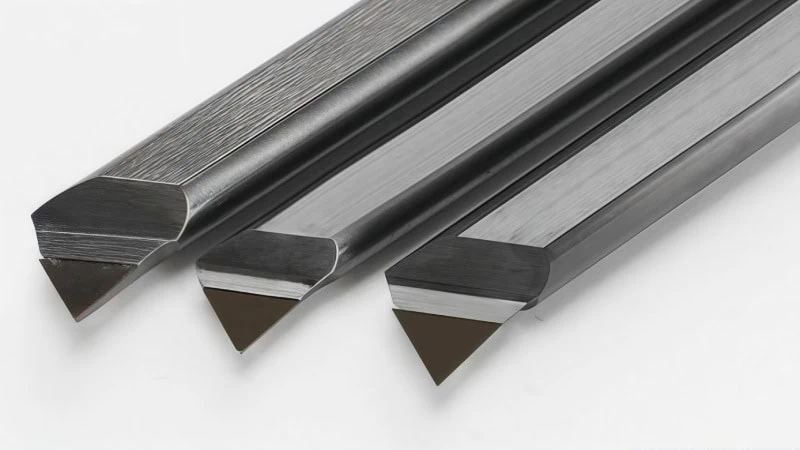
What are Critical Application Tips for Optimal PCBN Boring Performance?
You’ve selected the perfect PCBN boring bar – now, how do you actually use it effectively to get the best results and make it last?
Optimizing PCBN boring performance involves establishing the correct cutting parameters (speed, feed, depth of cut), ensuring maximum machine and workholding rigidity, applying the right coolant strategy (often dry machining), recognizing and addressing tool wear patterns promptly, and adjusting techniques for continuous versus interrupted cuts.
Establishing Effective Cutting Parameters (Speed, Feed, Depth of Cut Ranges)
Think of cutting parameters as the instructions you give the machine for how to perform the boring operation. Getting these right is essential for success with PCBN.
- Cutting Speed (Vc): This is how fast the surface of the workpiece moves past the cutting edge, often measured in surface feet per minute (SFM) or meters per minute (m/min). PCBN generally thrives at high cutting speeds compared to carbide when machining hard materials, thanks to its heat resistance. However, too high a speed can accelerate wear.
- Feed Rate (Fn): This is how quickly the tool advances into the workpiece per revolution of the spindle, often measured in inches per revolution (IPR) or millimeters per revolution (mm/rev). For PCBN, especially in finishing, feed rates are typically kept relatively low to ensure good surface finish and manage cutting forces. Too high a feed rate can cause tool chipping or breakage.
- Depth of Cut (DOC or Ap): This is how much material the tool removes in a single pass (the radial depth). PCBN is primarily used for finishing or semi-finishing passes, so depths of cut are usually light. Trying to take too heavy a cut can overload the brittle PCBN edge and lead to failure.
Finding the Sweet Spot: The ideal parameters create a balance between productivity, tool life, and surface finish. Starting points are usually based on the material being cut, the specific PCBN grade, and the operation type (roughing vs. finishing).
Crucial Reminder: Cutting parameter ranges (speed, feed, DOC) are highly dependent on the specific PCBN grade, workpiece material and hardness, machine stability, and coolant usage. Always start with the recommendations provided by your tooling supplier and be prepared to adjust based on actual performance and wear patterns. Don’t guess!
Ensuring Machine Rigidity and Stable Workholding is Crucial
Imagine trying to draw a perfectly straight line with a very sharp pencil, but your hand is shaking uncontrollably. The result won’t be good, right? The same principle applies to machining with PCBN.
- Machine Tool Rigidity: The machine tool itself (lathe or machining center) must be robust, well-maintained, and free from excessive vibration. Any looseness or vibration in the machine spindle, slides, or turret will be transferred to the cutting edge, potentially causing chipping or poor surface finish.
- Stable Workholding: How the workpiece is held (in a chuck, fixture, etc.) must be extremely secure. Any movement or vibration of the part during cutting will lead to problems. Ensure fixtures are strong and clamping pressure is adequate and evenly distributed.
- Minimize Tool Overhang: As mentioned in selection, keep the boring bar overhang (how far it sticks out from the holder) as short as absolutely necessary for the job. Longer overhangs act like levers, amplifying any vibration. Using a stiffer solid carbide shank boring bar can help compensate for longer necessary overhangs.
Why is rigidity so vital for PCBN? Because PCBN is very hard but also more brittle than carbide. It doesn’t tolerate vibration or sudden impacts well. A rigid, stable setup is non-negotiable for achieving good results and preventing premature tool failure.
Coolant Strategies: When to Use Dry vs. Wet Machining
Coolant (cutting fluid) can cool the tool and workpiece, lubricate the cutting zone, and help flush away chips. However, with PCBN, the strategy isn’t always straightforward.
- Dry Machining: Surprisingly, PCBN often performs best when run completely dry (no coolant), especially when boring hardened steels.
- Why? PCBN handles high temperatures very well. Eliminating coolant avoids potential “thermal shock” – rapid cycles of heating during the cut and quenching by coolant afterwards – which can cause microscopic cracks and shorten tool life. Dry machining is also cleaner and avoids coolant costs and disposal issues.
- Wet Machining: Sometimes, coolant is necessary or beneficial:
- Chip Evacuation: In deep holes or complex internal features, coolant flow can be essential to flush chips out and prevent them from packing or damaging the finished surface.
- Temperature Control: For parts sensitive to heat distortion, coolant can help maintain dimensional stability.
- Cast Iron: While some cast iron is machined dry, high-pressure coolant can sometimes be used effectively, particularly for chip control.
If Using Coolant: The key is consistent and high-volume application. Avoid intermittent coolant flow that causes thermal cycling. Ensure the coolant stream is accurately directed at the cutting zone.
Recommendation: Start with the assumption of dry machining for hardened steel, unless chip evacuation is a clear problem. For cast iron or other specific situations, consult your tool supplier’s recommendation regarding coolant use for the specific PCBN grade you’ve chosen.
Identifying and Addressing Common Tool Wear Patterns
Even super-hard PCBN tools wear out eventually. Learning to recognize how the tool is wearing can tell you a lot about whether your process is optimized. Checking the tool edge regularly (e.g., under magnification) is important.
Common wear types include:
- Flank Wear: This looks like a worn “land” or flattened area on the side (flank) of the cutting edge that was rubbing against the workpiece. This is the most common and desirable type of wear if it occurs gradually and evenly. It indicates the tool is working correctly, and you can often predict when to change the tool based on the width of this wear land.
- Cratering: A dished-out or crater-like depression forms on the top face of the insert, behind the cutting edge, caused by the friction and heat of the chip flowing over it. Excessive cratering might suggest the cutting speed is too high or the PCBN grade isn’t suitable for the chip flow characteristics.
- Chipping: Small pieces break away from the cutting edge. This is undesirable and often indicates a problem like:
- Too high a feed rate.
- Vibration or lack of rigidity.
- Interrupted cutting without the right grade or edge preparation.
- Hard inclusions in the material.
- Notching: Localized damage or wear occurring at a specific point, often at the depth-of-cut line (where the engaged edge meets the uncut shoulder) or where the tool enters/exits the cut. Can be caused by abrasion or work-hardened layers.
- Catastrophic Failure: The entire edge or a large portion breaks off suddenly. This usually points to a significant issue like excessive feed, a major impact, or a severely unstable setup.
Action: Monitor wear regularly. If you see excessive chipping or rapid wear other than gradual flank wear, investigate the cause (parameters, setup rigidity, grade/edge prep choice). Tool suppliers often provide guides on wear analysis or can help interpret wear patterns to optimize your process. Change tools based on predictable flank wear before catastrophic failure occurs.
Best Practices for Continuous vs. Interrupted Cuts
The nature of the cut significantly impacts how you should approach PCBN boring.
- Continuous Cuts:
- Definition: The cutting edge remains constantly engaged with the material throughout the bore (e.g., boring a simple, uninterrupted cylindrical hole).
- Approach: This is generally easier on the tool. You can typically use:
- Higher cutting speeds.
- PCBN grades with higher CBN content (more wear-resistant).
- Sharper edge preparations (if finishing).
- Focus is on managing heat and gradual flank wear.
- Interrupted Cuts:
- Definition: The cutting edge repeatedly enters and exits the material or encounters gaps (e.g., boring a hole with a keyway, cross-holes, splines, or starting on an uneven cast surface).
- Approach: This imposes repeated impacts on the cutting edge, requiring a different strategy:
- Reduce Cutting Speed: Lower speeds lessen the impact force.
- Use Tougher Grades: Select PCBN grades with lower CBN content and appropriate binders designed for toughness.
- Employ Stronger Edge Preps: Hones or chamfers are often essential to prevent the edge from chipping on impact.
- Ensure Maximum Rigidity: Stability is even more critical to absorb impacts smoothly.
- Maintain Consistent Feed: Avoid dwelling or sudden changes in feed rate during interruptions.
Understanding whether your application involves continuous or interrupted cuts is fundamental to selecting the right tool (covered in the previous section) and applying the correct operating parameters and techniques discussed here. Treating an interrupted cut like a continuous one is a common cause of premature PCBN tool failure.
Conclusion
Choosing and applying PCBN boring bars correctly unlocks significant advantages in productivity and quality when machining hard ferrous materials. By understanding their unique benefits, identifying the right applications, carefully selecting the appropriate grade and geometry, and implementing best practices for usage, manufacturers can effectively tackle challenging boring operations. While PCBN requires careful consideration and setup, the payoff in terms of speed, finish, tool life, and overall cost-efficiency in demanding applications makes it an invaluable tool in modern manufacturing.
Ready to leverage the power of PCBN for your hard material boring challenges?
Contact ZYDiamondTools today for expert consultation. Our team can help you select the optimal grade, geometry, and boring bar for your specific application, ensuring you achieve maximum performance and efficiency.
References
- hard turning1 – ZYDiamondTools blog post explaining the hard turning process and comparing it to grinding.
- Superalloys2 – MachiningDoctor overview of superalloys and their machining characteristics.
- Your Complete Guide to CBN (Cubic Boron Nitride) Cutting Tools3 – ZYDiamondTools comprehensive guide to CBN cutting tools.
- Edge Preparations4 – ZYDiamondTools blog post explaining edge radiusing (a type of preparation) for PCBN inserts.
